LSBM303 Case Study: Analyzing Hmlet's Internationalization Strategy
VerifiedAdded on 2023/06/18
|9
|2611
|375
Case Study
AI Summary
This case study examines Hmlet's internationalization, focusing on the drivers behind its expansion, particularly the availability of finance, company objectives, customer demand, active risk management, and market factors. It analyzes Hmlet's growth strategies in Singapore, Hong Kong, and Tokyo, highlighting both the benefits and risks of its portfolio-building approach. Furthermore, the study identifies potential challenges in the Asian market, including sustainability concerns, increased global instability, sourcing real estate, and navigating government regulations. It suggests actions for Hmlet to strengthen its position, such as leveraging advanced technology, identifying co-living typologies, and fostering community building. Desklib provides access to this and other solved assignments for students.
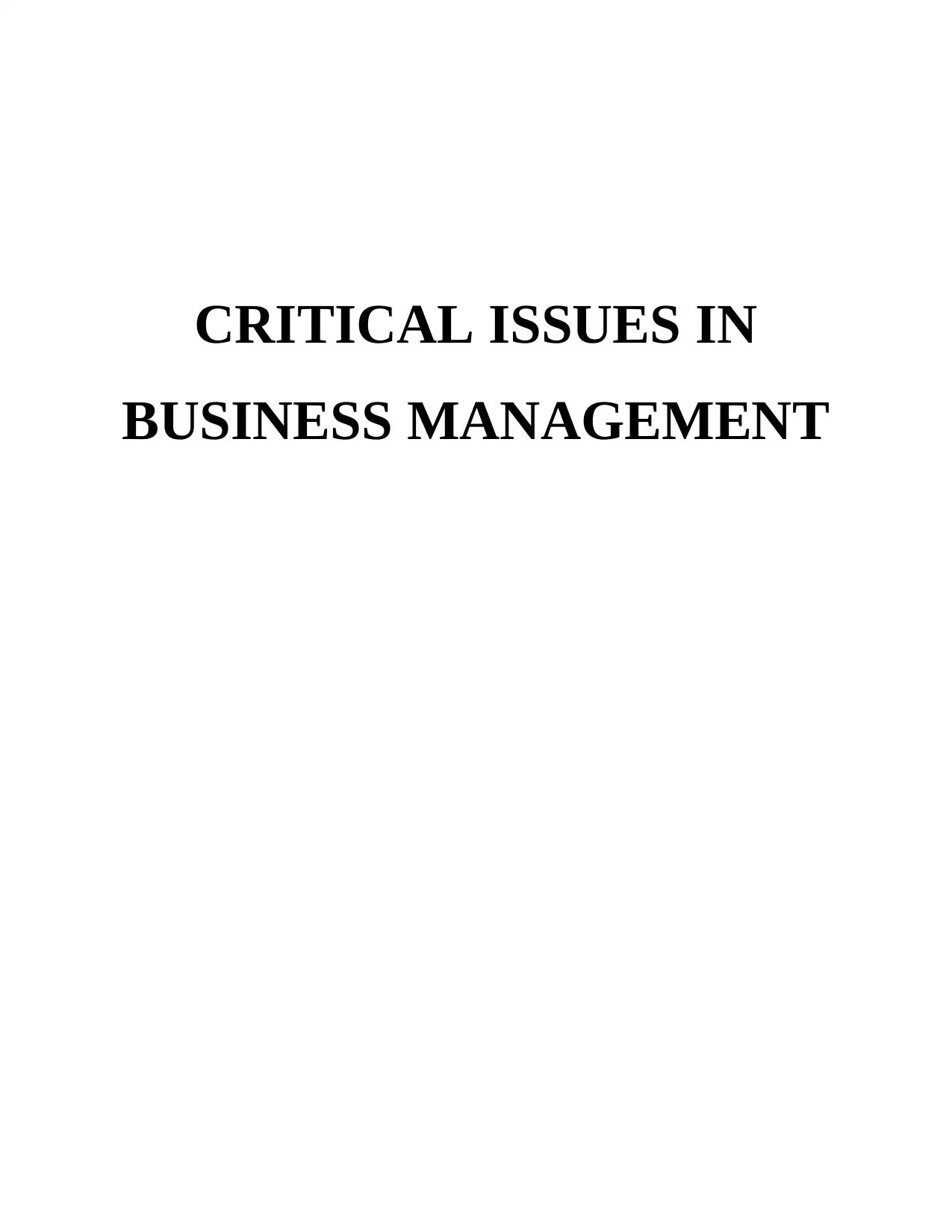
CRITICAL ISSUES IN
BUSINESS MANAGEMENT
BUSINESS MANAGEMENT
Paraphrase This Document
Need a fresh take? Get an instant paraphrase of this document with our AI Paraphraser
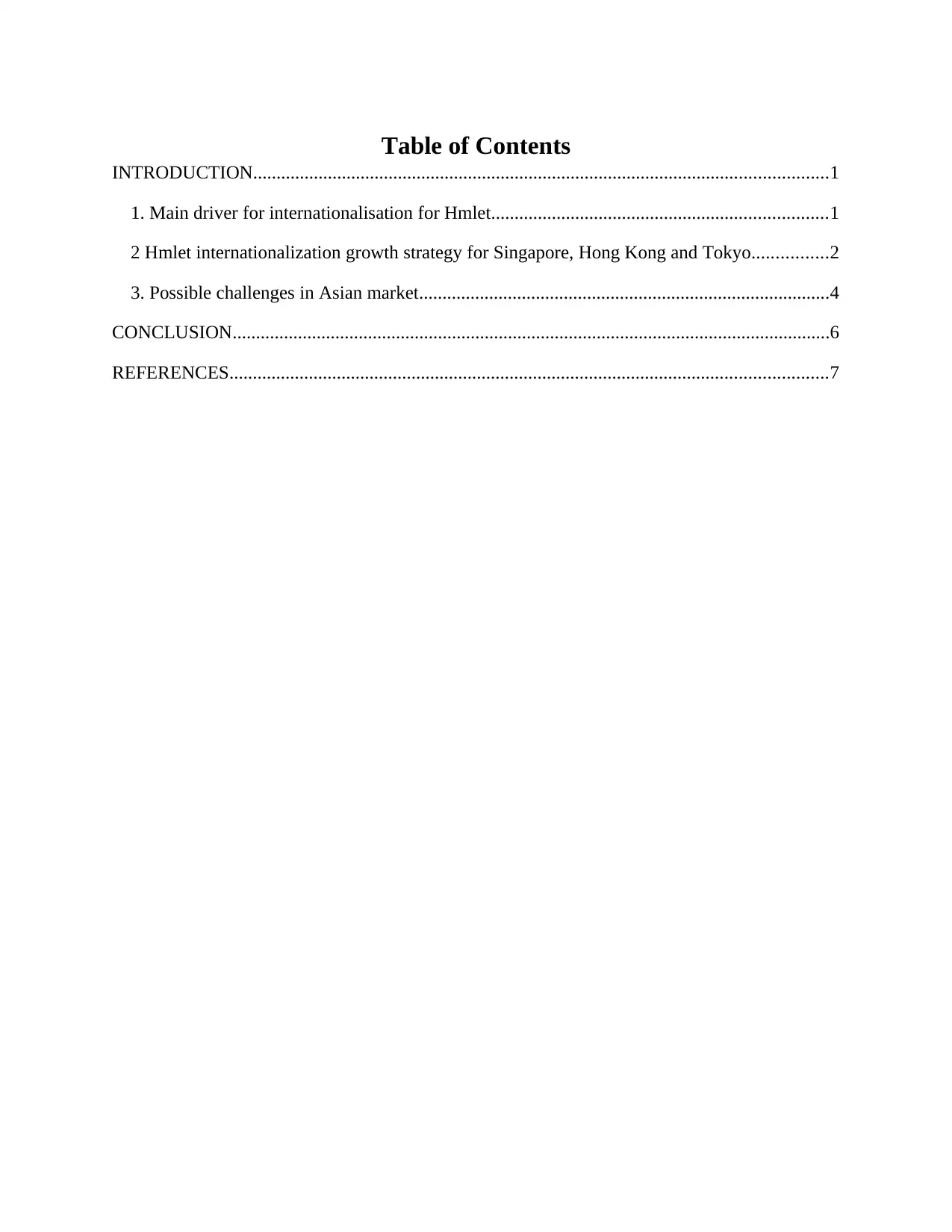
Table of Contents
INTRODUCTION...........................................................................................................................1
1. Main driver for internationalisation for Hmlet........................................................................1
2 Hmlet internationalization growth strategy for Singapore, Hong Kong and Tokyo................2
3. Possible challenges in Asian market........................................................................................4
CONCLUSION................................................................................................................................6
REFERENCES................................................................................................................................7
INTRODUCTION...........................................................................................................................1
1. Main driver for internationalisation for Hmlet........................................................................1
2 Hmlet internationalization growth strategy for Singapore, Hong Kong and Tokyo................2
3. Possible challenges in Asian market........................................................................................4
CONCLUSION................................................................................................................................6
REFERENCES................................................................................................................................7
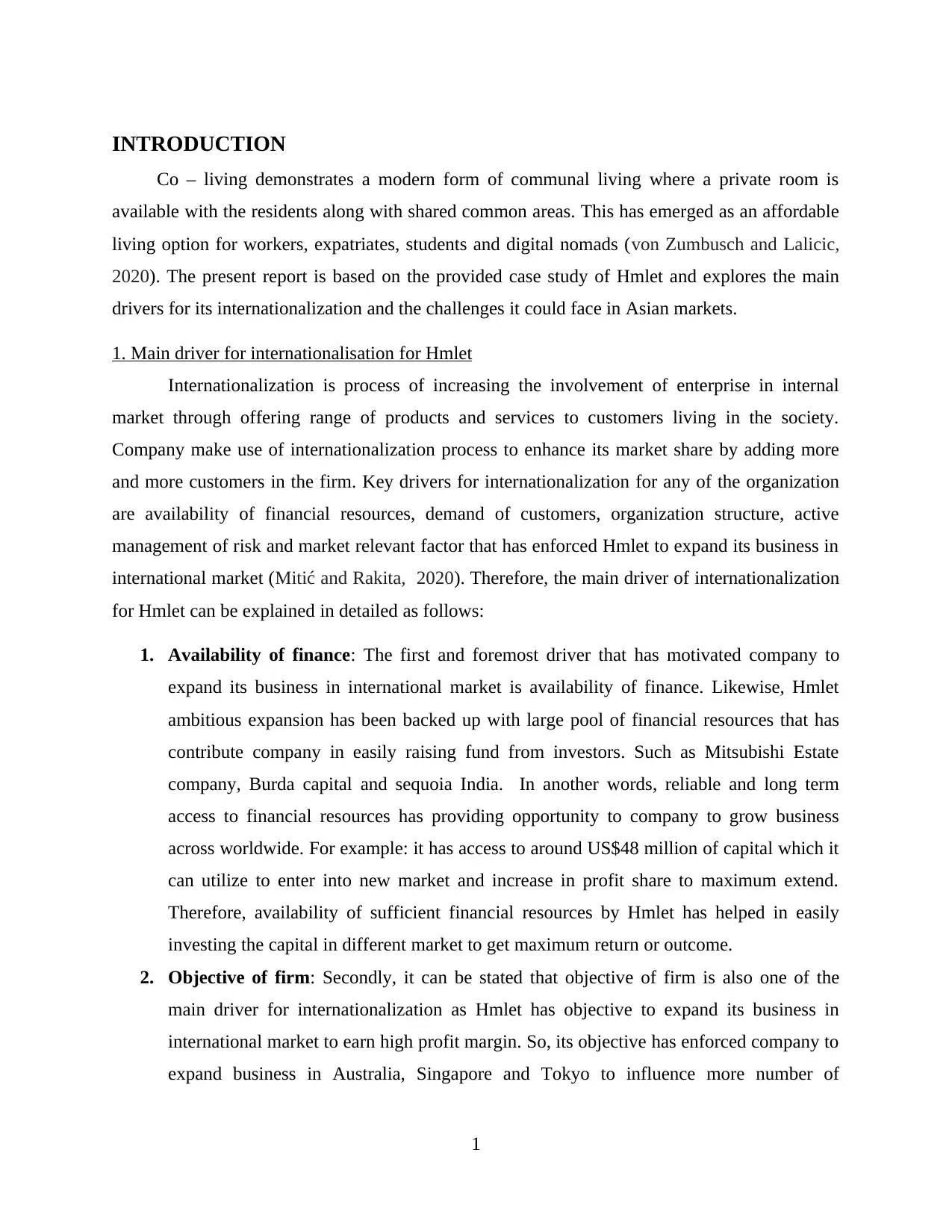
INTRODUCTION
Co – living demonstrates a modern form of communal living where a private room is
available with the residents along with shared common areas. This has emerged as an affordable
living option for workers, expatriates, students and digital nomads (von Zumbusch and Lalicic,
2020). The present report is based on the provided case study of Hmlet and explores the main
drivers for its internationalization and the challenges it could face in Asian markets.
1. Main driver for internationalisation for Hmlet
Internationalization is process of increasing the involvement of enterprise in internal
market through offering range of products and services to customers living in the society.
Company make use of internationalization process to enhance its market share by adding more
and more customers in the firm. Key drivers for internationalization for any of the organization
are availability of financial resources, demand of customers, organization structure, active
management of risk and market relevant factor that has enforced Hmlet to expand its business in
international market (Mitić and Rakita, 2020). Therefore, the main driver of internationalization
for Hmlet can be explained in detailed as follows:
1. Availability of finance: The first and foremost driver that has motivated company to
expand its business in international market is availability of finance. Likewise, Hmlet
ambitious expansion has been backed up with large pool of financial resources that has
contribute company in easily raising fund from investors. Such as Mitsubishi Estate
company, Burda capital and sequoia India. In another words, reliable and long term
access to financial resources has providing opportunity to company to grow business
across worldwide. For example: it has access to around US$48 million of capital which it
can utilize to enter into new market and increase in profit share to maximum extend.
Therefore, availability of sufficient financial resources by Hmlet has helped in easily
investing the capital in different market to get maximum return or outcome.
2. Objective of firm: Secondly, it can be stated that objective of firm is also one of the
main driver for internationalization as Hmlet has objective to expand its business in
international market to earn high profit margin. So, its objective has enforced company to
expand business in Australia, Singapore and Tokyo to influence more number of
1
Co – living demonstrates a modern form of communal living where a private room is
available with the residents along with shared common areas. This has emerged as an affordable
living option for workers, expatriates, students and digital nomads (von Zumbusch and Lalicic,
2020). The present report is based on the provided case study of Hmlet and explores the main
drivers for its internationalization and the challenges it could face in Asian markets.
1. Main driver for internationalisation for Hmlet
Internationalization is process of increasing the involvement of enterprise in internal
market through offering range of products and services to customers living in the society.
Company make use of internationalization process to enhance its market share by adding more
and more customers in the firm. Key drivers for internationalization for any of the organization
are availability of financial resources, demand of customers, organization structure, active
management of risk and market relevant factor that has enforced Hmlet to expand its business in
international market (Mitić and Rakita, 2020). Therefore, the main driver of internationalization
for Hmlet can be explained in detailed as follows:
1. Availability of finance: The first and foremost driver that has motivated company to
expand its business in international market is availability of finance. Likewise, Hmlet
ambitious expansion has been backed up with large pool of financial resources that has
contribute company in easily raising fund from investors. Such as Mitsubishi Estate
company, Burda capital and sequoia India. In another words, reliable and long term
access to financial resources has providing opportunity to company to grow business
across worldwide. For example: it has access to around US$48 million of capital which it
can utilize to enter into new market and increase in profit share to maximum extend.
Therefore, availability of sufficient financial resources by Hmlet has helped in easily
investing the capital in different market to get maximum return or outcome.
2. Objective of firm: Secondly, it can be stated that objective of firm is also one of the
main driver for internationalization as Hmlet has objective to expand its business in
international market to earn high profit margin. So, its objective has enforced company to
expand business in Australia, Singapore and Tokyo to influence more number of
1
⊘ This is a preview!⊘
Do you want full access?
Subscribe today to unlock all pages.

Trusted by 1+ million students worldwide
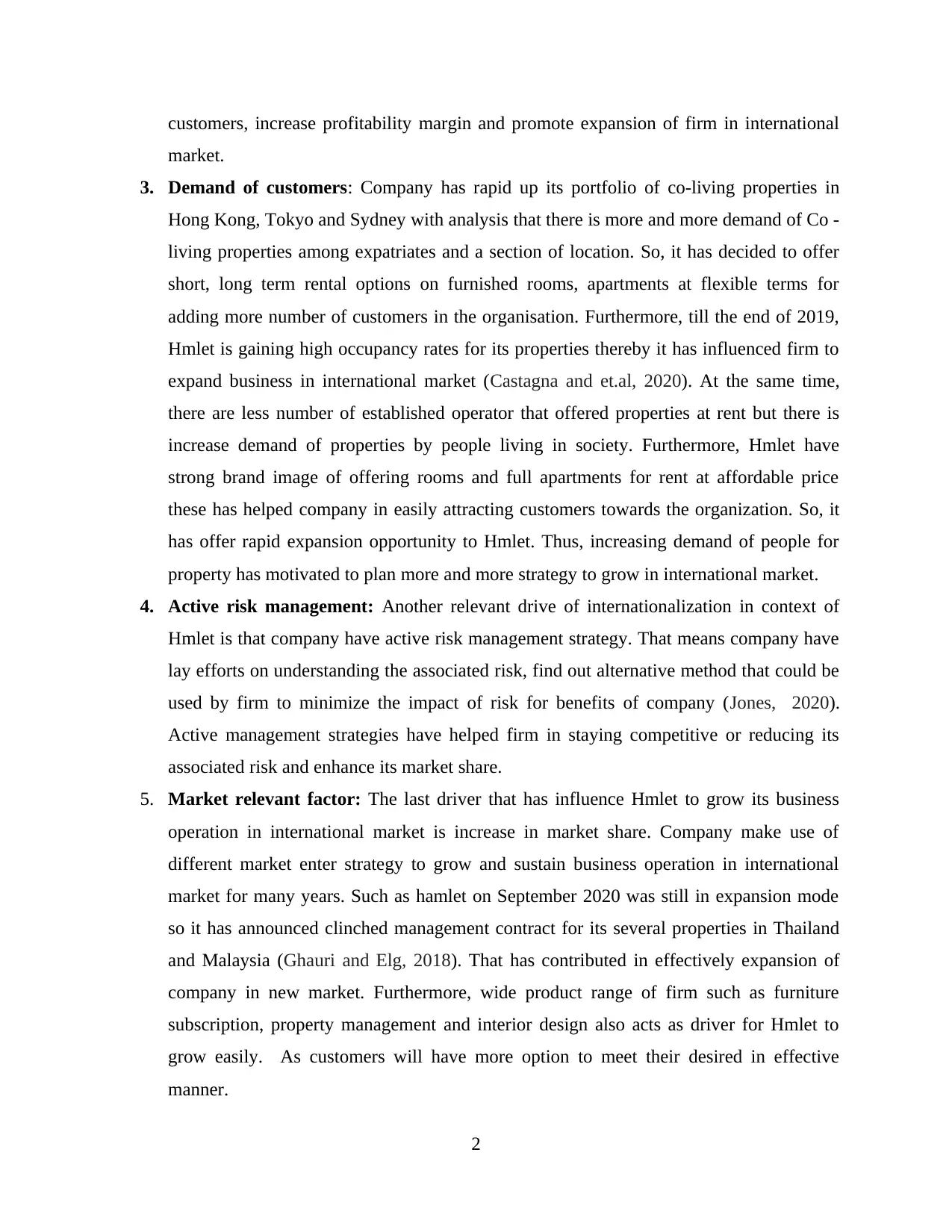
customers, increase profitability margin and promote expansion of firm in international
market.
3. Demand of customers: Company has rapid up its portfolio of co-living properties in
Hong Kong, Tokyo and Sydney with analysis that there is more and more demand of Co -
living properties among expatriates and a section of location. So, it has decided to offer
short, long term rental options on furnished rooms, apartments at flexible terms for
adding more number of customers in the organisation. Furthermore, till the end of 2019,
Hmlet is gaining high occupancy rates for its properties thereby it has influenced firm to
expand business in international market (Castagna and et.al, 2020). At the same time,
there are less number of established operator that offered properties at rent but there is
increase demand of properties by people living in society. Furthermore, Hmlet have
strong brand image of offering rooms and full apartments for rent at affordable price
these has helped company in easily attracting customers towards the organization. So, it
has offer rapid expansion opportunity to Hmlet. Thus, increasing demand of people for
property has motivated to plan more and more strategy to grow in international market.
4. Active risk management: Another relevant drive of internationalization in context of
Hmlet is that company have active risk management strategy. That means company have
lay efforts on understanding the associated risk, find out alternative method that could be
used by firm to minimize the impact of risk for benefits of company (Jones, 2020).
Active management strategies have helped firm in staying competitive or reducing its
associated risk and enhance its market share.
5. Market relevant factor: The last driver that has influence Hmlet to grow its business
operation in international market is increase in market share. Company make use of
different market enter strategy to grow and sustain business operation in international
market for many years. Such as hamlet on September 2020 was still in expansion mode
so it has announced clinched management contract for its several properties in Thailand
and Malaysia (Ghauri and Elg, 2018). That has contributed in effectively expansion of
company in new market. Furthermore, wide product range of firm such as furniture
subscription, property management and interior design also acts as driver for Hmlet to
grow easily. As customers will have more option to meet their desired in effective
manner.
2
market.
3. Demand of customers: Company has rapid up its portfolio of co-living properties in
Hong Kong, Tokyo and Sydney with analysis that there is more and more demand of Co -
living properties among expatriates and a section of location. So, it has decided to offer
short, long term rental options on furnished rooms, apartments at flexible terms for
adding more number of customers in the organisation. Furthermore, till the end of 2019,
Hmlet is gaining high occupancy rates for its properties thereby it has influenced firm to
expand business in international market (Castagna and et.al, 2020). At the same time,
there are less number of established operator that offered properties at rent but there is
increase demand of properties by people living in society. Furthermore, Hmlet have
strong brand image of offering rooms and full apartments for rent at affordable price
these has helped company in easily attracting customers towards the organization. So, it
has offer rapid expansion opportunity to Hmlet. Thus, increasing demand of people for
property has motivated to plan more and more strategy to grow in international market.
4. Active risk management: Another relevant drive of internationalization in context of
Hmlet is that company have active risk management strategy. That means company have
lay efforts on understanding the associated risk, find out alternative method that could be
used by firm to minimize the impact of risk for benefits of company (Jones, 2020).
Active management strategies have helped firm in staying competitive or reducing its
associated risk and enhance its market share.
5. Market relevant factor: The last driver that has influence Hmlet to grow its business
operation in international market is increase in market share. Company make use of
different market enter strategy to grow and sustain business operation in international
market for many years. Such as hamlet on September 2020 was still in expansion mode
so it has announced clinched management contract for its several properties in Thailand
and Malaysia (Ghauri and Elg, 2018). That has contributed in effectively expansion of
company in new market. Furthermore, wide product range of firm such as furniture
subscription, property management and interior design also acts as driver for Hmlet to
grow easily. As customers will have more option to meet their desired in effective
manner.
2
Paraphrase This Document
Need a fresh take? Get an instant paraphrase of this document with our AI Paraphraser
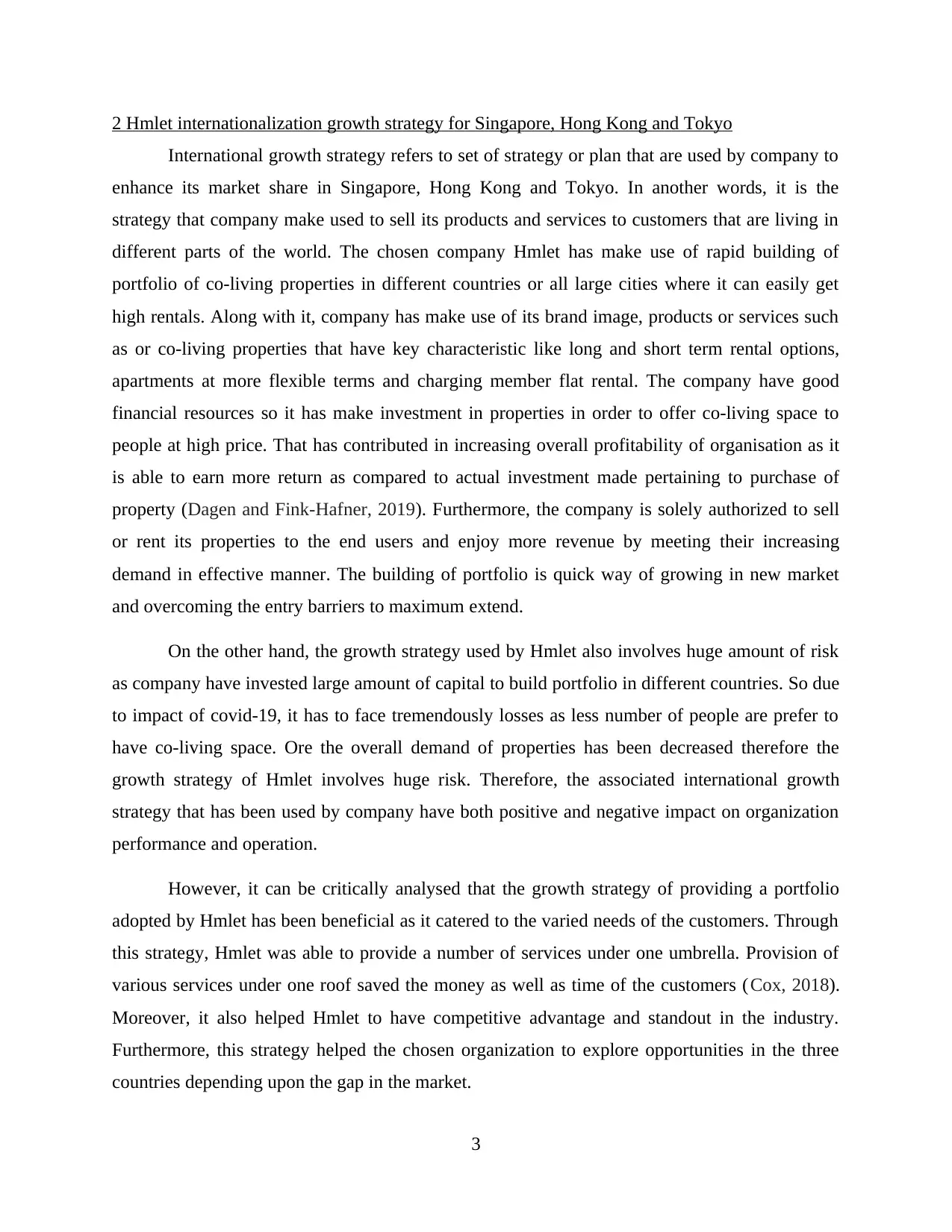
2 Hmlet internationalization growth strategy for Singapore, Hong Kong and Tokyo
International growth strategy refers to set of strategy or plan that are used by company to
enhance its market share in Singapore, Hong Kong and Tokyo. In another words, it is the
strategy that company make used to sell its products and services to customers that are living in
different parts of the world. The chosen company Hmlet has make use of rapid building of
portfolio of co-living properties in different countries or all large cities where it can easily get
high rentals. Along with it, company has make use of its brand image, products or services such
as or co-living properties that have key characteristic like long and short term rental options,
apartments at more flexible terms and charging member flat rental. The company have good
financial resources so it has make investment in properties in order to offer co-living space to
people at high price. That has contributed in increasing overall profitability of organisation as it
is able to earn more return as compared to actual investment made pertaining to purchase of
property (Dagen and Fink-Hafner, 2019). Furthermore, the company is solely authorized to sell
or rent its properties to the end users and enjoy more revenue by meeting their increasing
demand in effective manner. The building of portfolio is quick way of growing in new market
and overcoming the entry barriers to maximum extend.
On the other hand, the growth strategy used by Hmlet also involves huge amount of risk
as company have invested large amount of capital to build portfolio in different countries. So due
to impact of covid-19, it has to face tremendously losses as less number of people are prefer to
have co-living space. Ore the overall demand of properties has been decreased therefore the
growth strategy of Hmlet involves huge risk. Therefore, the associated international growth
strategy that has been used by company have both positive and negative impact on organization
performance and operation.
However, it can be critically analysed that the growth strategy of providing a portfolio
adopted by Hmlet has been beneficial as it catered to the varied needs of the customers. Through
this strategy, Hmlet was able to provide a number of services under one umbrella. Provision of
various services under one roof saved the money as well as time of the customers (Cox, 2018).
Moreover, it also helped Hmlet to have competitive advantage and standout in the industry.
Furthermore, this strategy helped the chosen organization to explore opportunities in the three
countries depending upon the gap in the market.
3
International growth strategy refers to set of strategy or plan that are used by company to
enhance its market share in Singapore, Hong Kong and Tokyo. In another words, it is the
strategy that company make used to sell its products and services to customers that are living in
different parts of the world. The chosen company Hmlet has make use of rapid building of
portfolio of co-living properties in different countries or all large cities where it can easily get
high rentals. Along with it, company has make use of its brand image, products or services such
as or co-living properties that have key characteristic like long and short term rental options,
apartments at more flexible terms and charging member flat rental. The company have good
financial resources so it has make investment in properties in order to offer co-living space to
people at high price. That has contributed in increasing overall profitability of organisation as it
is able to earn more return as compared to actual investment made pertaining to purchase of
property (Dagen and Fink-Hafner, 2019). Furthermore, the company is solely authorized to sell
or rent its properties to the end users and enjoy more revenue by meeting their increasing
demand in effective manner. The building of portfolio is quick way of growing in new market
and overcoming the entry barriers to maximum extend.
On the other hand, the growth strategy used by Hmlet also involves huge amount of risk
as company have invested large amount of capital to build portfolio in different countries. So due
to impact of covid-19, it has to face tremendously losses as less number of people are prefer to
have co-living space. Ore the overall demand of properties has been decreased therefore the
growth strategy of Hmlet involves huge risk. Therefore, the associated international growth
strategy that has been used by company have both positive and negative impact on organization
performance and operation.
However, it can be critically analysed that the growth strategy of providing a portfolio
adopted by Hmlet has been beneficial as it catered to the varied needs of the customers. Through
this strategy, Hmlet was able to provide a number of services under one umbrella. Provision of
various services under one roof saved the money as well as time of the customers (Cox, 2018).
Moreover, it also helped Hmlet to have competitive advantage and standout in the industry.
Furthermore, this strategy helped the chosen organization to explore opportunities in the three
countries depending upon the gap in the market.
3
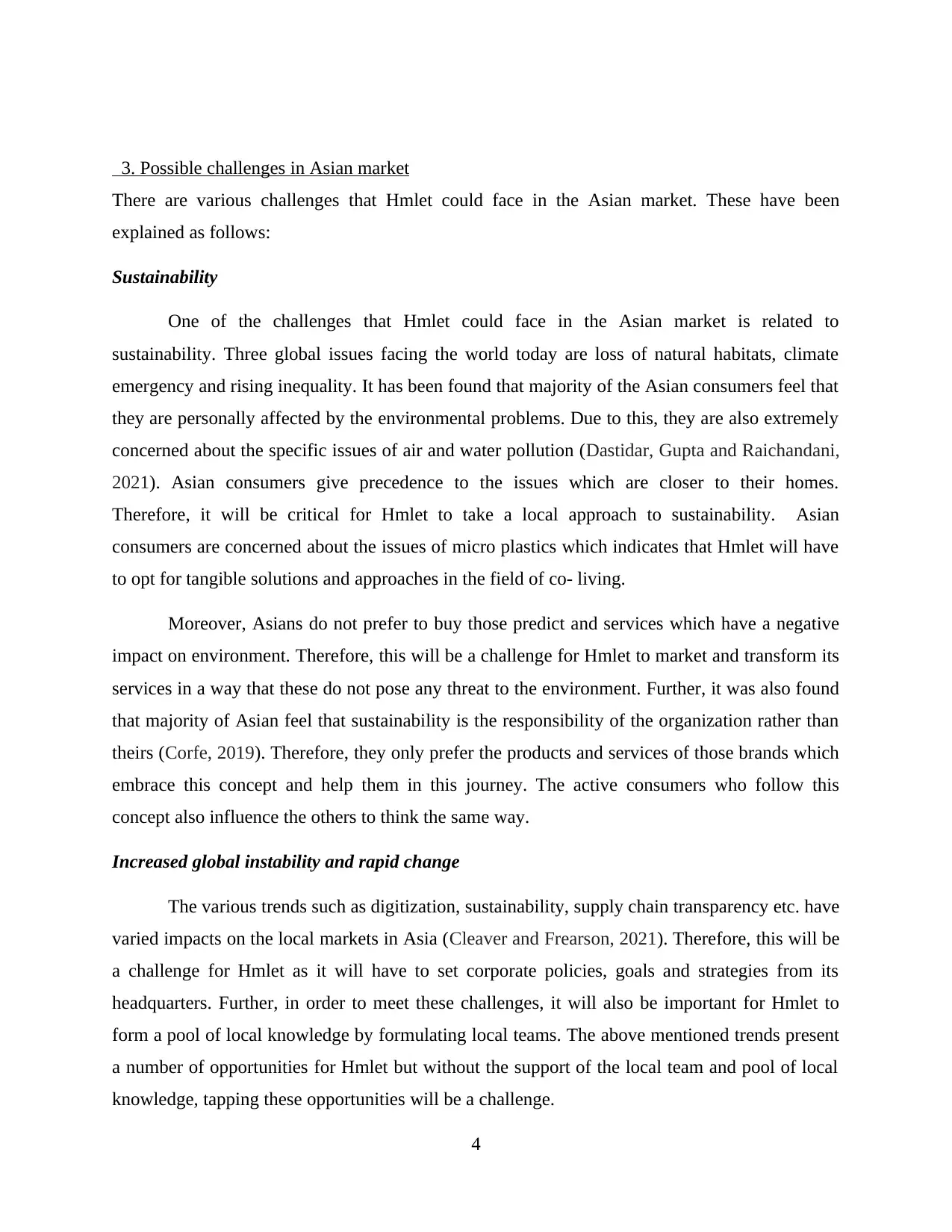
3. Possible challenges in Asian market
There are various challenges that Hmlet could face in the Asian market. These have been
explained as follows:
Sustainability
One of the challenges that Hmlet could face in the Asian market is related to
sustainability. Three global issues facing the world today are loss of natural habitats, climate
emergency and rising inequality. It has been found that majority of the Asian consumers feel that
they are personally affected by the environmental problems. Due to this, they are also extremely
concerned about the specific issues of air and water pollution (Dastidar, Gupta and Raichandani,
2021). Asian consumers give precedence to the issues which are closer to their homes.
Therefore, it will be critical for Hmlet to take a local approach to sustainability. Asian
consumers are concerned about the issues of micro plastics which indicates that Hmlet will have
to opt for tangible solutions and approaches in the field of co- living.
Moreover, Asians do not prefer to buy those predict and services which have a negative
impact on environment. Therefore, this will be a challenge for Hmlet to market and transform its
services in a way that these do not pose any threat to the environment. Further, it was also found
that majority of Asian feel that sustainability is the responsibility of the organization rather than
theirs (Corfe, 2019). Therefore, they only prefer the products and services of those brands which
embrace this concept and help them in this journey. The active consumers who follow this
concept also influence the others to think the same way.
Increased global instability and rapid change
The various trends such as digitization, sustainability, supply chain transparency etc. have
varied impacts on the local markets in Asia (Cleaver and Frearson, 2021). Therefore, this will be
a challenge for Hmlet as it will have to set corporate policies, goals and strategies from its
headquarters. Further, in order to meet these challenges, it will also be important for Hmlet to
form a pool of local knowledge by formulating local teams. The above mentioned trends present
a number of opportunities for Hmlet but without the support of the local team and pool of local
knowledge, tapping these opportunities will be a challenge.
4
There are various challenges that Hmlet could face in the Asian market. These have been
explained as follows:
Sustainability
One of the challenges that Hmlet could face in the Asian market is related to
sustainability. Three global issues facing the world today are loss of natural habitats, climate
emergency and rising inequality. It has been found that majority of the Asian consumers feel that
they are personally affected by the environmental problems. Due to this, they are also extremely
concerned about the specific issues of air and water pollution (Dastidar, Gupta and Raichandani,
2021). Asian consumers give precedence to the issues which are closer to their homes.
Therefore, it will be critical for Hmlet to take a local approach to sustainability. Asian
consumers are concerned about the issues of micro plastics which indicates that Hmlet will have
to opt for tangible solutions and approaches in the field of co- living.
Moreover, Asians do not prefer to buy those predict and services which have a negative
impact on environment. Therefore, this will be a challenge for Hmlet to market and transform its
services in a way that these do not pose any threat to the environment. Further, it was also found
that majority of Asian feel that sustainability is the responsibility of the organization rather than
theirs (Corfe, 2019). Therefore, they only prefer the products and services of those brands which
embrace this concept and help them in this journey. The active consumers who follow this
concept also influence the others to think the same way.
Increased global instability and rapid change
The various trends such as digitization, sustainability, supply chain transparency etc. have
varied impacts on the local markets in Asia (Cleaver and Frearson, 2021). Therefore, this will be
a challenge for Hmlet as it will have to set corporate policies, goals and strategies from its
headquarters. Further, in order to meet these challenges, it will also be important for Hmlet to
form a pool of local knowledge by formulating local teams. The above mentioned trends present
a number of opportunities for Hmlet but without the support of the local team and pool of local
knowledge, tapping these opportunities will be a challenge.
4
⊘ This is a preview!⊘
Do you want full access?
Subscribe today to unlock all pages.

Trusted by 1+ million students worldwide
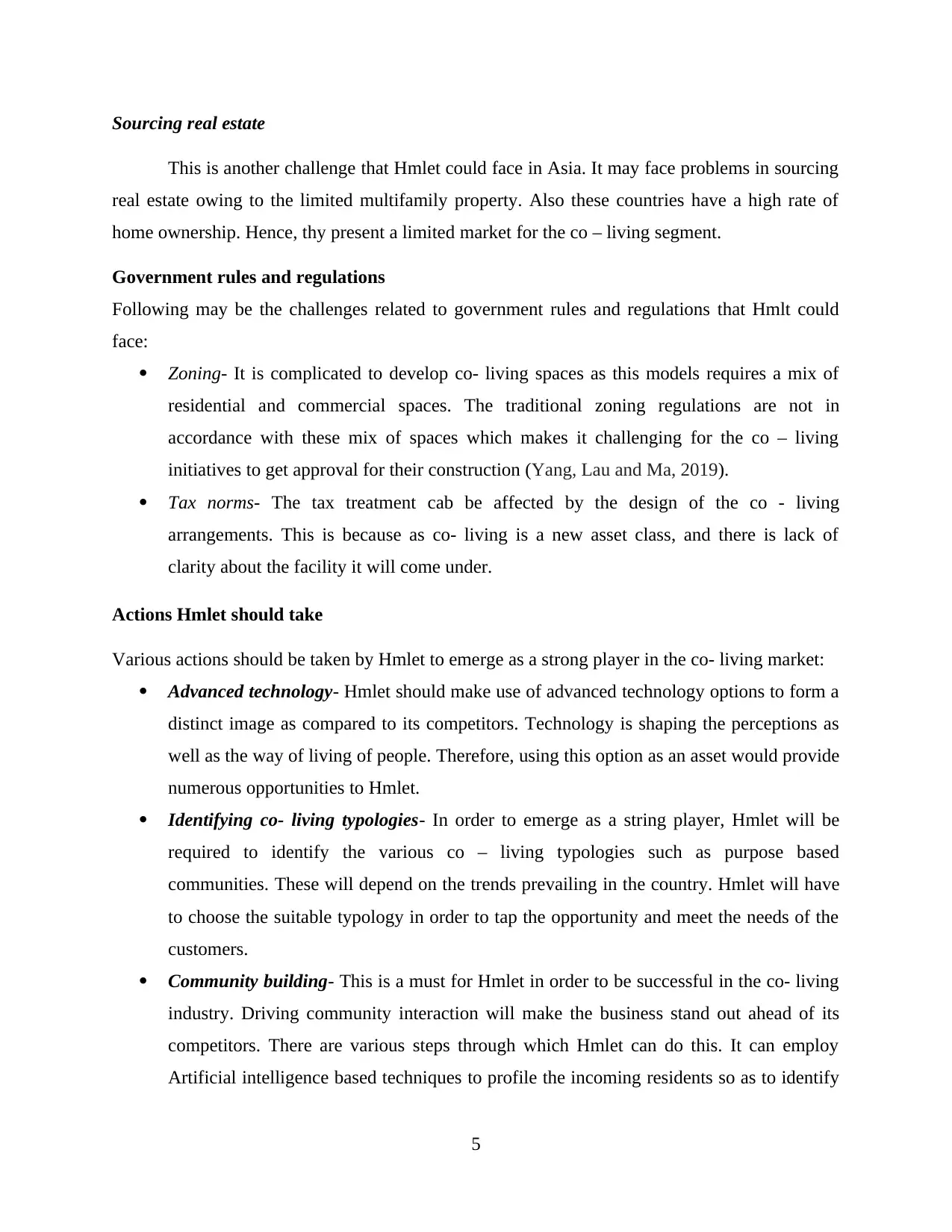
Sourcing real estate
This is another challenge that Hmlet could face in Asia. It may face problems in sourcing
real estate owing to the limited multifamily property. Also these countries have a high rate of
home ownership. Hence, thy present a limited market for the co – living segment.
Government rules and regulations
Following may be the challenges related to government rules and regulations that Hmlt could
face:
Zoning- It is complicated to develop co- living spaces as this models requires a mix of
residential and commercial spaces. The traditional zoning regulations are not in
accordance with these mix of spaces which makes it challenging for the co – living
initiatives to get approval for their construction (Yang, Lau and Ma, 2019).
Tax norms- The tax treatment cab be affected by the design of the co - living
arrangements. This is because as co- living is a new asset class, and there is lack of
clarity about the facility it will come under.
Actions Hmlet should take
Various actions should be taken by Hmlet to emerge as a strong player in the co- living market:
Advanced technology- Hmlet should make use of advanced technology options to form a
distinct image as compared to its competitors. Technology is shaping the perceptions as
well as the way of living of people. Therefore, using this option as an asset would provide
numerous opportunities to Hmlet.
Identifying co- living typologies- In order to emerge as a string player, Hmlet will be
required to identify the various co – living typologies such as purpose based
communities. These will depend on the trends prevailing in the country. Hmlet will have
to choose the suitable typology in order to tap the opportunity and meet the needs of the
customers.
Community building- This is a must for Hmlet in order to be successful in the co- living
industry. Driving community interaction will make the business stand out ahead of its
competitors. There are various steps through which Hmlet can do this. It can employ
Artificial intelligence based techniques to profile the incoming residents so as to identify
5
This is another challenge that Hmlet could face in Asia. It may face problems in sourcing
real estate owing to the limited multifamily property. Also these countries have a high rate of
home ownership. Hence, thy present a limited market for the co – living segment.
Government rules and regulations
Following may be the challenges related to government rules and regulations that Hmlt could
face:
Zoning- It is complicated to develop co- living spaces as this models requires a mix of
residential and commercial spaces. The traditional zoning regulations are not in
accordance with these mix of spaces which makes it challenging for the co – living
initiatives to get approval for their construction (Yang, Lau and Ma, 2019).
Tax norms- The tax treatment cab be affected by the design of the co - living
arrangements. This is because as co- living is a new asset class, and there is lack of
clarity about the facility it will come under.
Actions Hmlet should take
Various actions should be taken by Hmlet to emerge as a strong player in the co- living market:
Advanced technology- Hmlet should make use of advanced technology options to form a
distinct image as compared to its competitors. Technology is shaping the perceptions as
well as the way of living of people. Therefore, using this option as an asset would provide
numerous opportunities to Hmlet.
Identifying co- living typologies- In order to emerge as a string player, Hmlet will be
required to identify the various co – living typologies such as purpose based
communities. These will depend on the trends prevailing in the country. Hmlet will have
to choose the suitable typology in order to tap the opportunity and meet the needs of the
customers.
Community building- This is a must for Hmlet in order to be successful in the co- living
industry. Driving community interaction will make the business stand out ahead of its
competitors. There are various steps through which Hmlet can do this. It can employ
Artificial intelligence based techniques to profile the incoming residents so as to identify
5
Paraphrase This Document
Need a fresh take? Get an instant paraphrase of this document with our AI Paraphraser
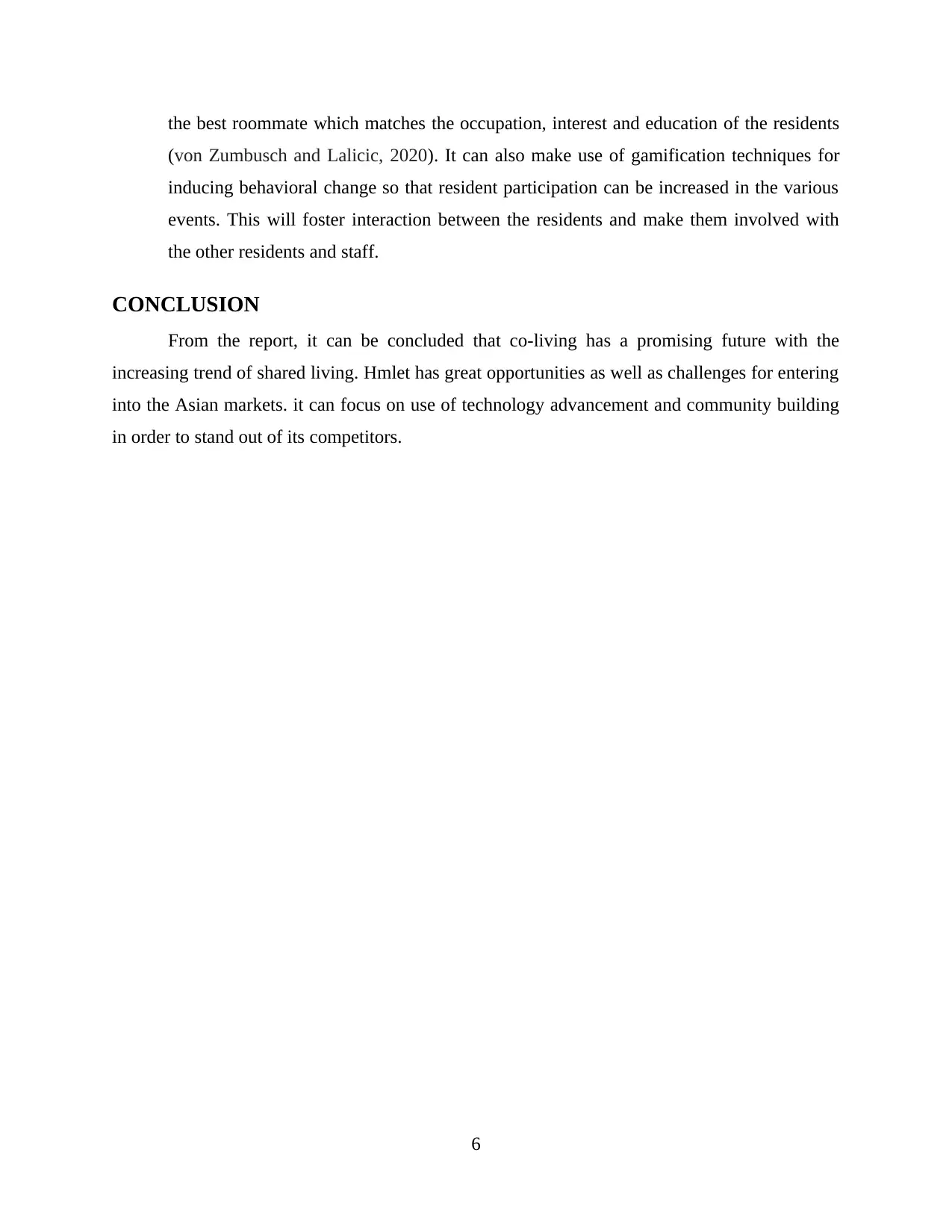
the best roommate which matches the occupation, interest and education of the residents
(von Zumbusch and Lalicic, 2020). It can also make use of gamification techniques for
inducing behavioral change so that resident participation can be increased in the various
events. This will foster interaction between the residents and make them involved with
the other residents and staff.
CONCLUSION
From the report, it can be concluded that co-living has a promising future with the
increasing trend of shared living. Hmlet has great opportunities as well as challenges for entering
into the Asian markets. it can focus on use of technology advancement and community building
in order to stand out of its competitors.
6
(von Zumbusch and Lalicic, 2020). It can also make use of gamification techniques for
inducing behavioral change so that resident participation can be increased in the various
events. This will foster interaction between the residents and make them involved with
the other residents and staff.
CONCLUSION
From the report, it can be concluded that co-living has a promising future with the
increasing trend of shared living. Hmlet has great opportunities as well as challenges for entering
into the Asian markets. it can focus on use of technology advancement and community building
in order to stand out of its competitors.
6
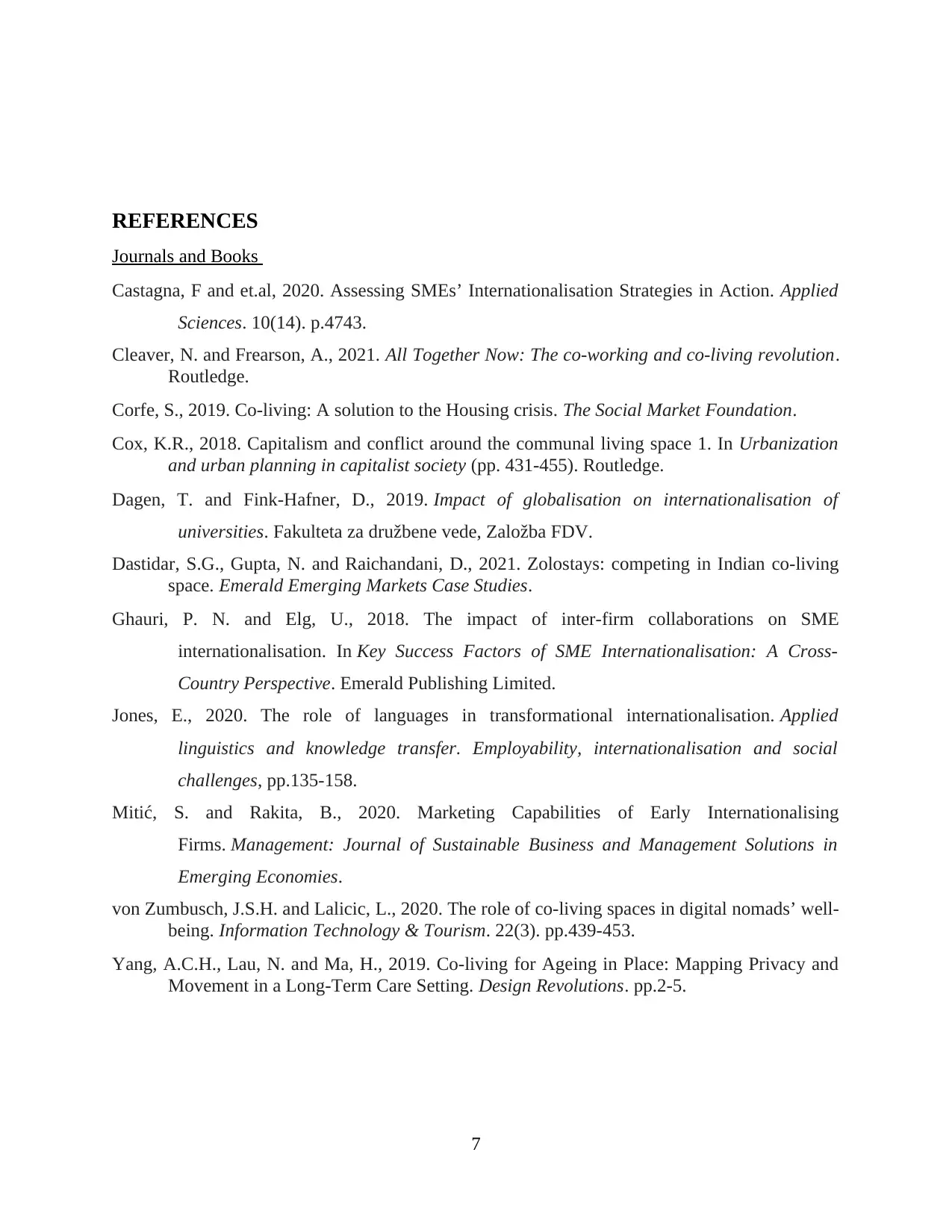
REFERENCES
Journals and Books
Castagna, F and et.al, 2020. Assessing SMEs’ Internationalisation Strategies in Action. Applied
Sciences. 10(14). p.4743.
Cleaver, N. and Frearson, A., 2021. All Together Now: The co-working and co-living revolution.
Routledge.
Corfe, S., 2019. Co-living: A solution to the Housing crisis. The Social Market Foundation.
Cox, K.R., 2018. Capitalism and conflict around the communal living space 1. In Urbanization
and urban planning in capitalist society (pp. 431-455). Routledge.
Dagen, T. and Fink-Hafner, D., 2019. Impact of globalisation on internationalisation of
universities. Fakulteta za družbene vede, Založba FDV.
Dastidar, S.G., Gupta, N. and Raichandani, D., 2021. Zolostays: competing in Indian co-living
space. Emerald Emerging Markets Case Studies.
Ghauri, P. N. and Elg, U., 2018. The impact of inter-firm collaborations on SME
internationalisation. In Key Success Factors of SME Internationalisation: A Cross-
Country Perspective. Emerald Publishing Limited.
Jones, E., 2020. The role of languages in transformational internationalisation. Applied
linguistics and knowledge transfer. Employability, internationalisation and social
challenges, pp.135-158.
Mitić, S. and Rakita, B., 2020. Marketing Capabilities of Early Internationalising
Firms. Management: Journal of Sustainable Business and Management Solutions in
Emerging Economies.
von Zumbusch, J.S.H. and Lalicic, L., 2020. The role of co-living spaces in digital nomads’ well-
being. Information Technology & Tourism. 22(3). pp.439-453.
Yang, A.C.H., Lau, N. and Ma, H., 2019. Co-living for Ageing in Place: Mapping Privacy and
Movement in a Long-Term Care Setting. Design Revolutions. pp.2-5.
7
Journals and Books
Castagna, F and et.al, 2020. Assessing SMEs’ Internationalisation Strategies in Action. Applied
Sciences. 10(14). p.4743.
Cleaver, N. and Frearson, A., 2021. All Together Now: The co-working and co-living revolution.
Routledge.
Corfe, S., 2019. Co-living: A solution to the Housing crisis. The Social Market Foundation.
Cox, K.R., 2018. Capitalism and conflict around the communal living space 1. In Urbanization
and urban planning in capitalist society (pp. 431-455). Routledge.
Dagen, T. and Fink-Hafner, D., 2019. Impact of globalisation on internationalisation of
universities. Fakulteta za družbene vede, Založba FDV.
Dastidar, S.G., Gupta, N. and Raichandani, D., 2021. Zolostays: competing in Indian co-living
space. Emerald Emerging Markets Case Studies.
Ghauri, P. N. and Elg, U., 2018. The impact of inter-firm collaborations on SME
internationalisation. In Key Success Factors of SME Internationalisation: A Cross-
Country Perspective. Emerald Publishing Limited.
Jones, E., 2020. The role of languages in transformational internationalisation. Applied
linguistics and knowledge transfer. Employability, internationalisation and social
challenges, pp.135-158.
Mitić, S. and Rakita, B., 2020. Marketing Capabilities of Early Internationalising
Firms. Management: Journal of Sustainable Business and Management Solutions in
Emerging Economies.
von Zumbusch, J.S.H. and Lalicic, L., 2020. The role of co-living spaces in digital nomads’ well-
being. Information Technology & Tourism. 22(3). pp.439-453.
Yang, A.C.H., Lau, N. and Ma, H., 2019. Co-living for Ageing in Place: Mapping Privacy and
Movement in a Long-Term Care Setting. Design Revolutions. pp.2-5.
7
⊘ This is a preview!⊘
Do you want full access?
Subscribe today to unlock all pages.

Trusted by 1+ million students worldwide
1 out of 9
Related Documents
Your All-in-One AI-Powered Toolkit for Academic Success.
+13062052269
info@desklib.com
Available 24*7 on WhatsApp / Email
![[object Object]](/_next/static/media/star-bottom.7253800d.svg)
Unlock your academic potential
Copyright © 2020–2025 A2Z Services. All Rights Reserved. Developed and managed by ZUCOL.



